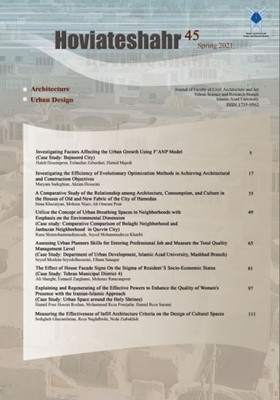بررسی کارایی روشهای بهینه سازی تکاملی در دستیابی به اهداف معماری و ساخت
الموضوعات : architecture
1 - دانشجوی کارشناسی ارشد دانشکده معماری و شهرسازی، دانشگاه فردوسی مشهد، مشهد، ایران
2 - استادیار دانشکده معماری و شهرسازی، دانشگاه فردوسی مشهد، مشهد، ایران.
الکلمات المفتاحية: روشهای فرااکتشافی, بهینه سازی, فرایند طراحی معماری, الگوریتم های تکاملی,
ملخص المقالة :
با افزایش محبوبیت روش های بهینه سازی در علوم مختلف، معماران نیز با اهداف گوناگون به استفاده از این روش ها در طراحیو اجرای ساختمان پرداخت هاند. نحوه ی کارکرد و ویژگی های ه رکدام، با توجه به جدید بودن آ نها در معماری، ناشناخته است.در این تحقیق، ضمن تدوین مبانی روش های بهینه سازی تکاملی، با مرور 77 مطالعه پیشین که در حوزه ی ساختمان، ازالگوریتم های بهینه سازی استفاده کرده اند؛ به بررسی میزان کارایی رو شها در دستیابی به اهداف معماری و ساخت، ب ه روشتحلیل محتوای متن اقدام م یگردد. الگوریتم های بهینه سازی با شش هدف مختلف در معماری پیاده سازی شد هاند؛ از این اهداف،بیشترین کاربرد مربوط به بهینه سازی نظام فضایی در کاربری مسکونی و بهینه سازی انرژی در ساختمان های اداری است. دربررس ی انجام شده، الگوریتم ژنتیک پرکاربردترین الگوریتم تکاملی و بهینه سازی انبوه ذرات، رایج ترین روش در تحقیقات مبتنیبر هوش جمعی است. با توجه به برخورد عمدتاً نظری پژوهشگران با این موضوع، طراحان نیازمند تعاملات بین رشته ای بیش تر باسایر محققین ب هویژه متخصصین کامپیوتر جهت پیاده سازی و عملیاتی شدن کاربرد الگوریتم ها می باشند.


